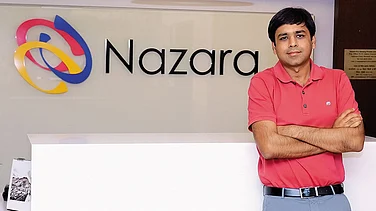From struggling with piles of bad loans in 2020 to becoming one of the best-performing banks in driving deposit growth in the last quarter of the current financial year, Yes Bank has outperformed in the past few quarters. In a conversation with Outlook Business, Prashant Kumar, managing director and chief executive officer (MD & CEO) of YES Bank, discusses how the bank is focusing on a brick-and-mortar model to enhance customers’ confidence and other key developments.
Yes Bank has recorded comparatively lower Net Interest Margins (NIMs) than other banks. How do you plan to improve that?
Lower NIMs are attributed to the fact that 11 per cent of the bank's assets are allocated to the RIDF (Rural Infrastructure Development Fund), which yields returns that are approximately 2 to 3 per cent below the repo rate. This allocation to the RIDF stems from non-compliance with priority sector lending (PSL) requirements in previous years.
As of March 31, 2024, the bank has fully met its PSL requirements. Consequently, no additional funds will need to be allocated to the RIDF. Furthermore, the amounts currently invested in the RIDF will gradually be returned to the bank upon maturity.
Currently, Rs 44,000 crore is invested in the RIDF. Of this, Rs11,000 crore is expected to be returned during the current financial year. The remaining 75per cent of the balance will be returned over the next three years. This process is anticipated to contribute an improvement of approximately 70 basis points to the bank's NIMs due to the redeployment of funds from the RIDF at higher yields.
Recently, you mentioned that the bank has taken certain corrective measures by tightening the underwriting standards and the customer eligibility criteria. Could you please clarify the recent changes that have been incorporated for the same?
In recent times, the entire banking industry has experienced higher delinquencies in the unsecured portfolio. To address this, our approach to underwriting in the unsecured segment has been strengthened to mitigate risks effectively.
When evaluating customers for unsecured loans, we traditionally rely on multiple parameters, including credit bureau scores, income levels, and specific criteria for customers who are new to credit or first-time borrowers. Recognizing the current environment, we have tightened these requirements to ensure more robust credit decision-making.
For instance, if a customer previously qualified for a personal loan with an income of Rs 25,000 per month, we have now raised it to Rs 35,000 for similar approvals. Additionally, for customers lacking documented income proof, we have shifted our stance. Instead of relying on imputed income models, we may choose not to finance unless credible income documentation is provided.
These adjustments reflect our commitment to improving underwriting quality. Our underwriting engine incorporates numerous markers for customer eligibility, and we regularly validate and tweak these models to align with market realities. By refining these eligibility criteria, we aim to balance portfolio growth with enhanced risk management.
There has been increasing concern about mule accounts in the banking sector. What initiatives are you implementing to address this issue?
We’re dealing with multiple issues related to account openings. Firstly, accounts are being set up with fictitious documents. Secondly, even with genuine documents, some individuals provide money to account holders to access their account information and misuse it. Additionally, there’s a troubling trend where customers are coerced into sharing sensitive information like passwords and OTPs, often through enticing offers or threats. To combat these problems, we have tightened the account opening process by verifying customer identities and thoroughly checking documents.
Customer profiling is also essential; we monitor transactions against expected activity to flag suspicious behaviour. We also act quickly on reports from customers or law enforcement. If a misuse is reported, we aim to promptly block the account to prevent further loss. We're coordinating closely with banks and agencies, and the Reserve Bank of India’s Innovation Hub is exploring the use of AI to combat mule accounts. While these challenges are significant, we are committed to finding solutions.
What is your plan for the brick-and-mortar model? In an era of digital banking, how are you planning to enhance a bank's physical presence?
We have already opened 40 branches this year, which we were planning to do in the current financial year. In the last two years, we have also opened almost 125 branches. But from next year onwards we will be opening 80 branches per year. So, we plan to open almost 400 branches in the next 5 years.
I think we need to make a distinction. If you have a brick-and-mortar branch, then only you are able to use the customer base around that branch. That is a separate thing that there is no need for the customer to come to the branch and do the transaction by using mobile banking or online banking. But I think any customer, unless they see a branch, I am saying in a physical branch, nobody has a comfort. I guess nobody would be comfortable in terms of putting their own money into that bank.
So, I think having physical branches is very critical for any bank so that the customer has that confidence. When opening a branch, it should be in a small format. This allows for a physical presence where customers can resolve problems in person, while transactions can be done online or via mobile.



























